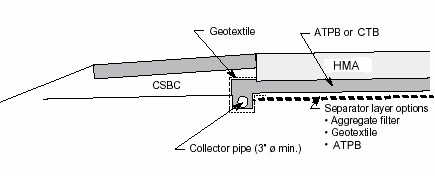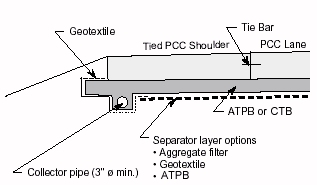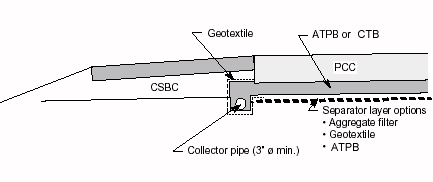Subsurface drainage is concerned with removing water that percolates through or is contained in the underlying subgrade. This water, typically the result of a high water table or exceptionally wet weather, can accumulate under the pavement structure by two chief means:
- Gravity flow. Water from surrounding areas can be absorbed by the soil then flow by gravity to areas underneath the pavement structure. In pavement with high air voids (above 8 – 9 percent), water can percolate down through the pavement structure itself.
- Capillary rise. Capillary rise is the rise in a liquid above the level of zero pressure due to a net upward force produced by the attraction of the water molecules to a solid surface (e.g., soil). Capillary rise can be substantial, up to 6 m (20 ft.) or more. In general, the smaller the soil grain size, the greater the potential for capillary rise. Often, capillary rise is a problem in areas of high groundwater tables.
Most pavements have performed adequately without considering these effects. However, HMA pavements can fail because of subgrade support deterioration as a result of excessive moisture or other water-related problems. While the best solution is usually to prevent water infiltration with surface drainage measures, subsurface drainage can be useful, however it needs to be done judiciously, because it may be somewhat akin to treating the symptom rather than the problem. Subsurface drainage consists of three basic elements (Figures 1, 2 and 3):
- A permeable base to provide for rapid removal of water which enters the pavement structure. Based on recent research from California, asphalt treated permeable base layers may strip and become clogged with fines thus weakening the overall pavement structure.
- A method of conveying the removed water away from the pavement structure. At the least, this may consist of a base sloped towards a drainage ditch. At the most, this may consist of a pipe collector system.
- A filter layer (such as a geotextile, graded aggregate layer or HMA) to prevent the migration of fines into the permeable base from the subgrade, subbase or shoulder base material. Excess fines in the permeable base will clog its drainage routes and render it ineffective. Depending upon the subgrade and pavement structure a filter layer may not be used.



